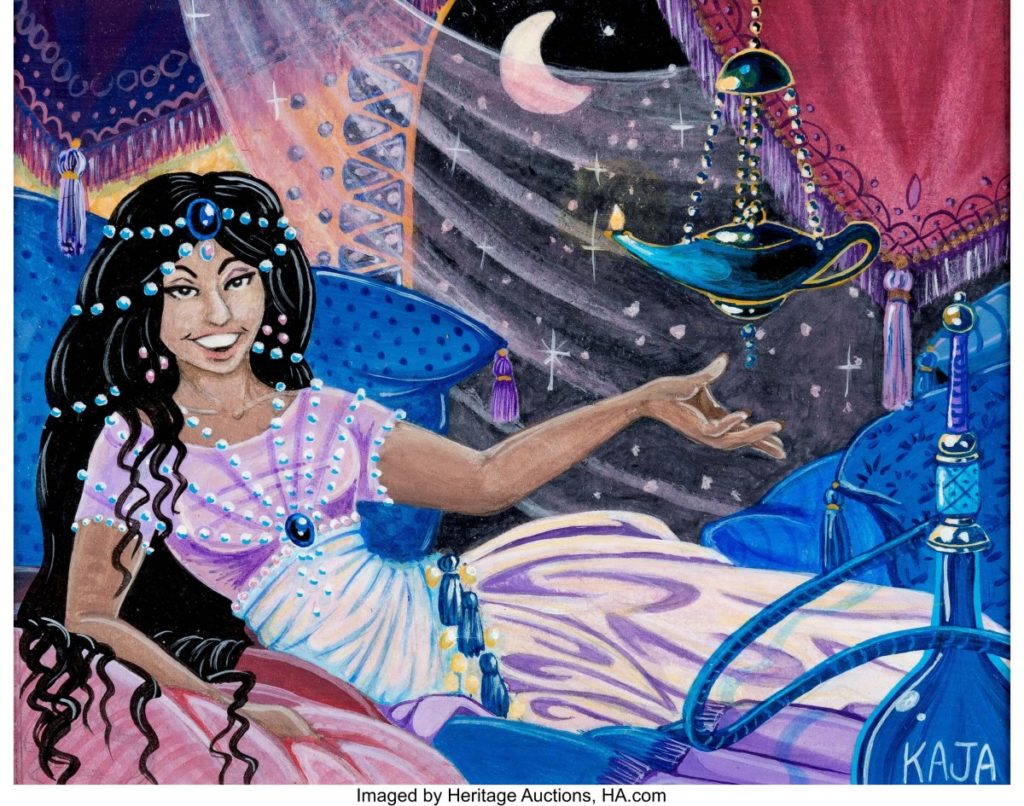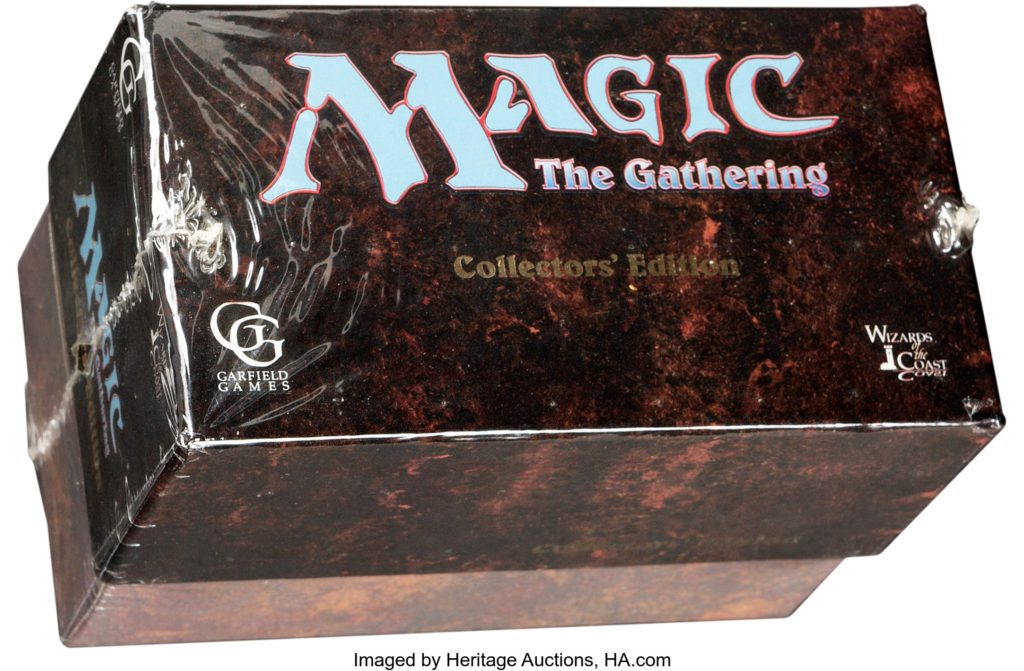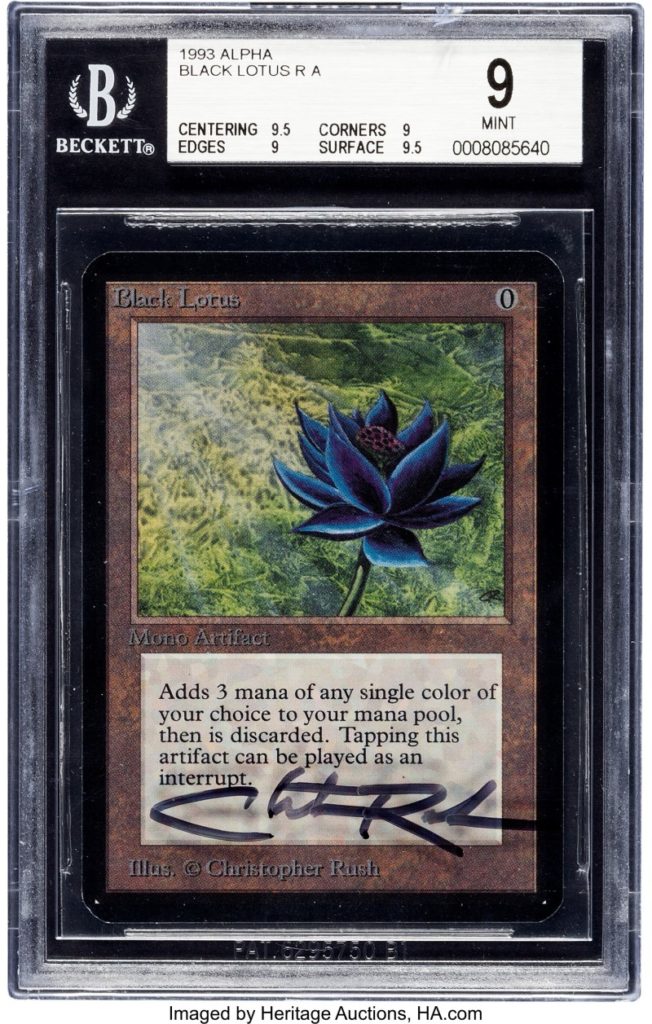
The multi-player card game Magic: The Gathering celebrated its 25th anniversary (the first year to be officially deemed “vintage” in collecting circles) in 2018, although a strong secondary market for rare cards has existed for some time. Cards now trade daily on online marketplaces and prices can range from a few cents to more than $30,000.

AUCTION PREVIEW: A Magic: The Gathering Collectors’ Edition Unopened Box Set (Wizards of the Coast, 1993) has already been bid up to $6,000 with about 10 days to go in Heritage Auctions’ July 9-12 Comics & Comic Art Auction. The sale features 29 unique lots of slabbed cards and box sets both sealed and open.
Designed by Dr. Richard Garfield, Magic: The Gathering (commonly called “MTG” or just “Magic”) caused an immediate sensation when it debuted in 1993, and it continues to thrive, with more than 20 million players. It is credited with inspiring numerous early imitators and such famous successors as Pokémon and Yu-Gi-Oh! Magic: The Gathering Magic can be played by two or more players in various formats, the most common of which uses a deck of more than 60 cards; each game represents a battle between wizards known as “planeswalkers,” who employ spells, artifacts and creatures depicted on individual Magic cards to defeat their opponents.
Collectors seek out rare cards and those from early editions, but values are constantly in flux, said Ben Bleiweiss, General Manager of Acquisitions at StarCityGames.com, the world’s largest Magic: The Gathering store, with an inventory that includes an extensive selection of out-of-print sealed product and more than 20 million individual cards. Here Bleiweiss outlines why values fluctuate and how the secondary market for cards and related memorabilia has evolved during the past 25 years.
How has this amazing game created a lasting impact on worldwide culture and generated popular spin-offs?
Ben Bleiweiss: Magic combines several elements of popular games and cultural touchstones, plus it is both portable and timeless. It combined the elements of sports card collecting (putting together complete sets/one of each), gamesmanship (the cards have a use – playing a game) and a fantasy art element (heavy influence in classic fantasy works). Since all you need is a single deck of Magic cards to play, it’s a very portable game, and one that has found a lot of popularity with U.S. military personnel for this very reason!
One of the reasonS Magic has endured and thrived for nearly 25 years is because the cards have an intrinsic use in and of themselves beyond collection purposes. The values of individual cards are constantly in flux, because newly printed cards can affect the play value (and therefore demand) on all previously-printed cards. There is a very healthy tournament structure around Magic (Giving out several million dollars of prize money annually between official and unofficial events), which drives value on the cards even further.
Do collectors find more value in owning a single card from these early printings or do they look to own an entire set?
In my estimation, true collectors (people who purchase Magic for the sole purpose of collecting cards, and do play with them or buy them as investments) probably make up less than 1 percent of the total number of people who are involved in Magic. However, this is because many of the early Magic sets are extremely expensive (A Near Mint Alpha set, for instance, will set you back at least $150,000 at this point). So the people who are true collectors A) tend to have a lot more disposable capital than the average player, and B ) do tend to try to put together complete sets. There are even a few collectors that collect graded sets (usually from BGS), where they only include cards that are graded 9.0 or higher in these sets!

ABOVE: Christopher Rush is one of the most popular Magic artists of all time. His art is featured on the most coveted of all Magic cards. A single Magic: The Gathering Black Lotus Alpha Edition, BGS 9, signed on case by Rush (Wizards of the Coast, 1993) sold at Heritage Auctions in August 2019 for an astounding $84,600.
Was Magic an instant success when it debuted in 1993? How rare are the first published cards?
Magic was an instant success when it debuted at Gen Con in 1993. The initial (Alpha) print run sold out immediately, as did the Beta (second printing of Alpha) and Unlimited (third printing of Alpha) print runs.
There were initially 2.6 million Alpha cards printed (enough to make 1,100 copies of each Alpha Rare, or 1,100 total possible Alpha sets), with the number rising to 7.8 million for Beta (3,200 of each Rare/possible sets) and 40 million for Unlimited (18,500 of each Rare/possible sets). The first few expansion sets (Arabian Nights, Antiquities, Legends and The Dark) all had very low print run numbers, starting with Revised (the first reprint set after Unlimited) and Fallen Empires (the first expansion set after The Dark). Print run numbers were much higher and were enough to meet demand.
I’ve learned that several specific early cards tend to be the most valuable in today’s market (e.g. the “Power Nine” – Ancestral Recall, Black Lotus, Mox Emerald, Mox Jet, Mox Pearl, Mox Ruby, Mox Sapphire, Time Walk, Timetwister). Why are collectors drawn to own these cards? How high have you seen prices climb for examples in near mint-mint condition?
One of the innovations of Magic cards is the introduction of rarity within a pack of cards. A typical Magic pack contains 15 cards. In Alpha/Beta/Unlimited, these would be one Rare card, three Uncommon cards, and 11 Common cards. For Beta/Unlimited, there were 117 Rare, 95 Uncommon and 75 Common cards in the set (One less Common and one less Rare in Alpha, due to Circle of Protection: Black and Volcanic Island being omitted from the print sheet). In order to get a complete set of Beta cards, assuming no duplication, a player would have to open a minimum of 117 packs of cards (one of each Rare), and likely you’d have to open many, many more than that due to duplication.
The Power Nine cards (listed above) were all Rare cards in Alpha/Beta/Unlimited. These are among the nine most powerful cards for gameplay ever printed, and were among the cards discontinued in the Revised printing of Magic due to being “too powerful”. The most powerful (and expensive) of these is Black Lotus. An Alpha Black Lotus is basically the most valuable/desired regular-print Magic card (one that isn’t a misprint or from an unofficial release). I’d equate it to an Action Comics #1 or a T-206 Honus Wagner card, as far as the status it holds within the Magic-collecting community.
What would you say are the most beloved or nostalgic cards for those who first played the game in the mid-1990s?
This is a tricky question, because as stated above, many people collect different cards for different reasons. For those who like the art of Magic, Serra Angel is likely one of the most iconic/nostalgic cards from Magic’s early days – from a player’s perspective, maybe something like Shivan Dragon, Atog, or Swords to Plowshares; from a collector’s perspective, the Power 9, and the original Dual Lands (Badlands, Bayou, Plateau, Savannah, Scrubland, Taiga, Tropical Island, Tundra, Underground Sea, Volcanic Island from Alpha/Beta/Unlimited/Revised).
Does the same sense of nostalgia for these same cards appear in today’s players, or do today’s players have their own unique set of characters and cards dear to their hearts?
A little of each. There are many tournament formats in Magic. The most popular one, Standard, only allows cards printed within the past three expansion blocks (approximately 18 months worth of cards – each block is two sets, and each set is released quarterly). For formats that allow older cards all the way back to the original set releases (Legacy/Vintage), there’s a very healthy dose of nostalgia for these very same cards. For newer players, there’s generally a sense of attachment to whatever cards either (A) the person first started playing with or (B) had the most fun building a deck around. It’s best to say that players more often than not do get a sense of nostalgia about Magic cards, but the exact cards they become attached to are extremely varied.
How have fans responded to the appearance of the original art from these cards appearing for sale online or at auction?
The market for original Magic artwork has exploded within the past two years. Pieces from the first few sets (Alpha through The Dark) have started commanding exorbitant prices. The original artwork of Alpha/Beta/Unlimited Rares commands a minimum $10,000 price tag, with iconic pieces hitting the $50,000+ range. People have really started collecting Magic cards in earnest, and those that either (A) are the most popular cards, or (B) have really stand-out artwork demand a much higher price tag. Unpopular pieces usually sell in the $300-1,000 range, depending on the artist and size of the piece.

ABOVE: The original painting by Kaja Foglio for Magic: The Gathering: Arabian Nights “Shahrazad” Card (Wizards of the Coast, 1993) sold at Heritage for $72,000 in July 2018.
Are Magic collectors plagued by fakes and reproductions? If so, where do these come from and how can a collector protect their investment and collection from “bad cards?”
Over the past three years, there has been a very marked increase in the number and quality of counterfeit cards being introduced into the market, primarily from China. The good news is that none of these cards is of a high enough quality that anyone who works with Magic cards for a living should be fooled by them. I’d always recommend sending cards off to an official grading service (such as Beckett Grading Service), because Beckett will not only grade the cards, but certify their authenticity.
Magic: The Gathering is a registered trademark of Wizards of the Coast, Inc. Magic: The Gathering and all magic images are copyright © Wizards Of The Coast, Inc.


Leave a Comment